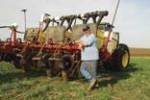
Don't try to sell Doug Davenport some wing-ding technology on a promise. On the other hand, if the Kingman, Ind., farmer can see how it would benefit his operation and improve his bottom line, he's more than happy to listen.
Davenport participated in a panel discussion on precision farming technology at the Bi-State Crops Meeting last week. Dennis Bowman, a University of Illinois Extension educator, moderated the panel. What Bowman wanted to know first and foremost was what technologies each person used, or believed farmers could use to help improve their bottom line.
"Yield monitors have helped me leaner about and demonstrate where I need more tiling," Davenport says. "Its' helped me get down to studying what tile spacing is best in various soil types that we farm. I'm also interested in sub-surface irrigation. What' I've learned about crop response by studying yield maps ahs helped me make decisions about tile spacing in all the soils that we farm."
Yield monitor data has also been useful for him in other ways, but it's the tiling aspect that has produced tangible, dollar and cents results, he says. He's not the only farmer who has seen the need for improved drainage in black and white, or in colored maps, by suing a yield monitor to document it. What many people find, especially when they first begin using a yield monitor isn't a year or at least in a field with drowned-out spots, is that the influence of the wet spot extends out much farther in a circular pattern than what they would have imagined. In other words, the yield monitor documents that yields are lower even where the crop isn't totally destroyed, or even as far as where it's not visibly obvious that there is still much effect lingering from wet weather.
The other tool that Davenport likes is auto-guidance. Not only does it leave him more refreshed after a day's work, but it was essential this spring in helping get soybeans planted in a short time. "We could run 33-hour days since we could run at night," he says. "That was worth a lot this year."
He also says that automatic row shut-offs for corn seeding and for spraying to prevent overlap of both products are no-brainers. Anything that is obviously saving him money is worth considering, he concludes.
About the Author(s)
You May Also Like




